This is taken from an article published in ‘The Local Historian’, August 2011, Volume 41, No. 3.
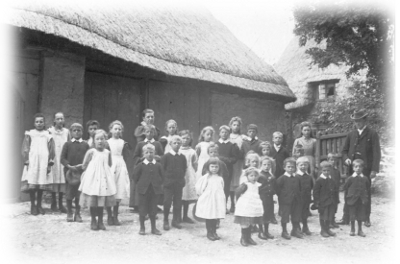
Rev Elkington and school children outside Elsfield school
There is some confusion about the date when a school in Elsfield was established. The Victoria County History of Oxfordshire states that there was no school in 1818 and that children were sent to the neighbouring parish of Stowood, paid for by Mrs Oglander, a prosperous member of the community who lived at the Manor, but that a school had been established by 1833. The school master at Stowood was Henry Else Chapman, who died at the age of 68 in 1820 and is buried in the churchyard in Elsfield. This may have triggered the founding of a school in Elsfield itself, since there are comments about the parish school in the 1825 document from the North estate. The document says ‘There are twelve children put to school by Mrs Oglander and there are eight more which want education.’ Three pence a week was paid for children who were taught to read and four pence by those who were taught to work, which meant spending part of the day learning from servants how to do their job. It was thought to improve their job prospects. ‘There is a great want of books at the Parish school,’ noted the clerk, which indicates that Elsfield children obtained their schooling in the village in 1825 rather than in Stowood, which is outside the parish boundary and that the founding of the school is at least eight years earlier than the Victoria County History suggests. There was a Sunday school which Mrs Oglander also supported, paying £2 while the clergyman also contributed so all the children of the parish could attend.
We do not know the name of the teacher in 1825 but by 1851 it was Ann, wife of John Humphrey, a mason. She was already past the modern retirement age in 1851, being 67 years old, so it is no surprise to find that the teacher in 1861 was Sarah Jane James, an unmarried girl of eighteen. Correspondence between the Reverend Gordon and Colonel North indicate that there was also a Miss Knowle, who succeeded Mrs Humphreys and preceded Miss James…
The Reverend Gordon’s correspondence with Colonel North in March 1860 reveals that Miss James had been in post for a quarter of a year and appeared suitable. It was time, he thought, to come to a definite arrangement about pay. The previous incumbent, Miss Knowle, was being paid £35. This was made up of £2 each from the three farmers in the village, Mr Treadwell, Mr Greaves and Mr William Parsons, Mr Herbert Parsons at the Manor gave £6 and Colonel North contributed £23 and a ton of coal. ‘Books and other materials are supplied by us’, wrote the Reverend Gordon. He suggested reducing the £35 salary to £26 for Miss James and proposed that the £9 saved from the salary be deducted from Colonel North’s contribution so he would contribute £14. The farmers would readily give £1 each and Reverend Gordon would give £3. Mr Herbert Parsons, ‘of whose increasing kindness and liberality to Elsfield it is impossible to speak too highly’ would make up the difference of £6. There is no mention of the National Society (the National Society for Promoting the Education of the Poor in the Principles of the Established Church, which was a source of funding for church, as opposed to chapel, schools) paying anything towards the upkeep of the school, as they were doing in the nearby village of Marston but there is evidence of contact between the two schools since in 1870 Sarah Jane James married Sutcliffe Gibson Greenwood, the school master at Marston, and left the village.
The same year saw the introduction of the new Education Act, which caused turmoil in Elsfield. A correspondence between Reverend Richard Gordon and Colonel North reveals the state of agitation in the Reverend Gordon’s mind.
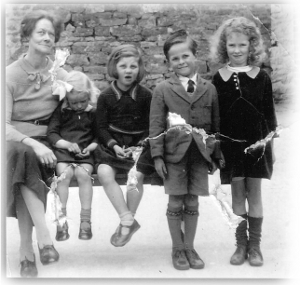
Mrs Cox with Helena Colwell, Dorothy Footitt, Geoffrey Laffor
The problem was that if the school were to become a Public Elementary School, as opposed to the Voluntary school which it then was, with a more substantial amount of grant from the government, there would have to be certain conditions imposed by the state. One of those the vicar feared most was lack of control over the curriculum. He was afraid that religious teaching would be abolished. The school, being funded entirely by the local gentry, had not previously had to submit itself to an inspection and the vicar feared interference in the life of the school by inspectors. He had obviously read carefully the literature sent from the Department of Education because he was concerned on two counts, as he put it in a letter dated March 21st 1871, ‘efficiency and sufficiency.’
The new teacher, Fanny Hardwick, aged twenty-two was described by the Reverend Gordon as ‘not certified but (she) is a good and painstaking teacher and fairly qualified. So she may be considered suitable and efficient.’ The building was a different matter. ‘The schoolroom has sufficient square feet but being low I fear it may be cubically deficient.’
Colonel North tried to calm his fears and expressed the hope that ‘the Government Inspector may not interfere with the School House or School Mistress. ‘He commented on the building: ‘The school seems big enough for the village. The new mistress seems quite sufficiently learned for our purpose.’ The Reverend Gordon was not too sure about the building. He considered the possibility of raising the roof, which would be extremely expensive and asked that the building be assigned for use as a school in perpetuity. This Colonel North said he could not do. ‘I can’t make over the freehold to the clergyman and church warden because it would require Mr North’s sanction which he won’t give. Mr North would refuse to give a site for any Protestant school’. (Mr North was a more senior member of the family and appears from this comment to have been a member of the Roman Catholic church). The school was duly inspected and the correspondence shows how chaotic the inspection system was at that time. All Board schools and managers of voluntary schools had direct access to the Department of Education which led to administrative difficulties and explains the note of desperation in the communication from Mr K.W. Bellaire, the Inspector. He wrote from the Education Department on 3 Jan 1872, refusing the Reverend Gordon’s invitation to dinner but requesting an invitation to lunch. ‘Excuse this behaviour please, I am so overwhelmed with engagements that I do not know where to turn’.
The Reverend Gordon wrote to Colonel North to tell him that the school had passed its inspection very satisfactorily and had ‘every reason to hope we shall not be interfered with if we can only push the Room and its appurtenances into such a state as will satisfy the Education Department.’ The Education Department required a boarded floor, standard desks, separate offices for girls and boys. The vicar pointed out that if they had security of tenure people within the village would be happy to bring the building and appurtenances up to the standard required of them.
They attempted to discover from the Education department how the report had been received but, as the Reverend Gordon pointed out, ‘The Privy Council is so overwhelmed with reports there is no knowing when they will get round to processing the report. Mr Bellaire is one of the oldest and ablest on the staff and very much deferred to.’ But ‘Until we receive their imperious fiat we can only guess its nature from what may have fallen from the Inspector himself.’
By December 1872, the Reverend Gordon was spelling out the consequences of not having a lease. If they did not have a lease, they could not comply with the Education Act ‘and the school may become rate funded. Mr Herbert Parsons and the farmers do not want this.’ By the 7th December the vicar was replying to Colonel North that a 21 year lease would solve all their problems and they would accept on any terms. The churchwardens, who would be signatories to the lease, were Mr Herbert Parsons, who had been a churchwarden since he moved to Elsfield, and Mr John Greaves, farmer, who had been a churchwarden even longer. The lease was finally granted on 24th March 1873. It ran from 25th May 1873 for 21 years and there would be a yearly rent of £11 in two equal half yearly payments. Colonel North wrote to the Reverend Gordon on 5th December 1873 to reassure him that although the school would have to pay rent, as long as Colonel North ‘has anything to do with the estate, you will not have to pay it.’ One can assume therefore that Colonel North, who administered the estate on behalf of the family, would ensure that, whatever the legal agreement, the school did not have to pay rent for its building.
In a letter to the solicitor who was dealing with the matter, Mr Innes, in April 1873 the Reverend Gordon informed him that there was spare capacity at the school. ‘24 out of 41 houses in the parish have no children in them.’ However it was still worthwhile making the schoolroom bigger as the number of children might well increase. The only way to do this was to annexe the adjoining blacksmith’s shop, ‘the noisy work of which interrupts the work of the school. Mr Herbert Parsons and the farmers think it would be an improvement.’
And no doubt Miss Hardwick would agree with them. As an uncertificated teacher she and the Reverend Gordon were trying to improve her qualifications. On 29 Sept 1871 Reverend Gordon wrote from Elsfield Vicarage to the Secretary of the Education Department in London stating that Miss Fanny Hardwick, mistress of this small mixed school for the last 13 months would like to attend the next Christmas examination for a certificate of merit at Fish Ponds near Bristol. He describes her as 22 years of age, trained for two years 1864-66 at Oseney, has been employed in different schools and is now in sole charge at Elsfield school.
She was turned down presumably because the school was a Voluntary, not a Board school. The vicar wrote again, pointing out that Fanny Hardwick was applying for the exam in her own name and it had nothing to do with Elsfield school. She wanted to become qualified to take charge of a public elementary school ‘be it here or elsewhere’.
On 21 October 1871 he received a brusque communication stating that ‘As the managers decline to give an express undertaking that the school will be conducted as a public elementary school within the meaning of the Public Elementary School Act 1870 (Section 7), my Lords cannot sanction the admission of your teacher to examination under Article 471.’ It seems likely that the reason for the refusal was the fact that there was no governing body, the sole manager of the school being the Reverend Gordon.
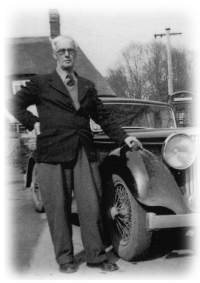
Mr Stace outside the school
Not only did Miss Hardwick have to put up with the noise and dirt of the blacksmith’s shop as she tried to teach and the impossibility of improving her qualifications, her living quarters left much to be desired. The Reverend Gordon wrote to Colonel North on the 4th April 1871 ’With regard to the Teacher’s House it is only half of a by no means large cottage far from equal when undivided to three or four cottages in the village, those for instance of Ann Gammon, Thos. Gardner and Joseph Locke. The division leaves only one room upstairs and one down so it is only suitable for single tenants or married couple without family.’
There are two forms completed by Rev. Gordon for the Department of Education but obviously not sent. One concerns Miss Hardwick, completed probably in 1876 and another, following her resignation, about Mrs Daws the teacher appointed to fill her place. It may be that these forms were not sent because Reverend Gordon died in December 1877.
Questions asked by the Department of Education concerning teachers in the school appear to modern eyes to be very intrusive. They ask about the moral probity of the teachers and how they spend their free time. Miss Hardwick was described as never having been reprimanded for laxity of morals and she described her evenings as being spent in inspecting the girls’ needlework and the boys’ knitting, self improvement, attending choir practice conducted by the clergyman’s daughter, and ‘home duties which include keeping my cottage (or at least trying to keep it) in order myself, planning for my plain, simple though comfortable dinner for the day following and at least ironing one hour on Sunday evening.’
To improve their chances of getting a good teacher, the Reverend Gordon then asked Colonel North if they could restore the cottage into one house again to attract a good teacher.
Judging from Mrs Daws’ answers to the questions asked by the Department of Education they did not succeed. Born on 13th May 1851, she had had seven years experience as a teacher before coming to Elsfield. She was not certificated, not willing to be, and had had no training. She had assisted for twelve months in a school which was under inspection in Wormbridge, Herefordshire. She was married to a carpenter and they had two daughters aged eight and five, both born in Wiltshire, so they were obviously newcomers to the village. Mrs Daws was considerably less forthcoming about her evenings than Miss Hardwick, merely stating that they were spent in family and household concerns.
The school at this time had nineteen pupils and the form gives some interesting details about the accounts. Voluntary contributions were £41, of which the school pence from the children was £6-2-8d, with money brought forward from the precious year being £5-0-6d, a total of £52-3-2d. Annual expenditure was £38-1-4d on salary, £2-10-3d on books and ‘other appurtenances’, presumably chalk and stationery. Fuel and lighting cost £1-18-6d while rent for the school room and house was £2-19-0d. Other expenses came to one shilling.
The school was described as a public school i.e. held in premises secured by deed for Education, with Managers acting under that deed, who appoint and control the Teacher. It was not a Private school with private managers or indeed an Adventure school conducted by the teacher at his (or her) own risk. The building belonged to Colonel North and Baroness North. It was used for a Sunday school and night school during the winter months and also for choir practice long after school hours once a week. The room was 19.2 ft long, 16.4 ft. wide and the ceiling height 12 ft. There was ample light, good drainage, sufficient ventilation, separate offices for boys and girls and the building was in good repair, so the Reverend Gordon’s fears about the inadequate building expressed in his previous letters to Colonel North were unfounded. It was not however necessarily true, since according to the Log Books it was not until 1881 that the floor of the schoolroom was boarded and while the work was being done the children had lessons in the school house. The school was stuffy in summer and sometimes very cold in winter if the supply of coal and faggots did not last out. In 1888 the order of lessons had to be changed round because there was not enough light to sew by in the afternoon so the sewing had to be done in the morning. The school was also probably not very clean. There was a cleaner only once a week in the early years of the Log Book records and the children did the rest of the work. It was not until 1908 that a full time cleaner was employed.
The form goes on to assert that the girls were taught plain needlework and the school would be conducted as a Public Elementary school, though again this is not necessarily true, since there was no school committee, the Reverend Gordon being sole manager.
This is all the information available from the documents left by the Reverend Gordon, but the history of the school continues in the Log Books, which cover the period from 1881 until the closure of the school in 1955. The struggle to achieve high standards of teaching, a major preoccupation with the Reverend Gordon, continued under subsequent vicars.
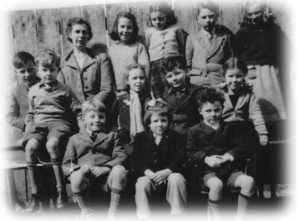
Mrs Jennings and school children
Judging by the comments of the HMI recorded in the Log Books, his hard work in establishing and maintaining a school with high teaching standards for Elsfield children was of little avail. Until the 1920s, when Miss Stace was appointed to run the school, the Inspectors were highly critical of the methods of teaching and the curriculum and were outspoken in their condemnation of the pupils who were regularly described as unintelligent. In September 1881 Frances Daws was replaced by Miss Collins when the running of the school had been taken over by the Reverend Langhorne following the death of the Reverend Gordon. In October Miss Collins was told by the HMI, the vicar’s brother, T. Langhorne, that the arithmetic was not up to scratch. The following January the children’s work was inspected again and she was told there had been no improvement. The Diocesan Inspector (this was a Church inspection, separate from the government inspection) in February 1882 said, ‘The disposition to restlessness of the younger children should be checked.’ The younger children were being taught by a monitress, and as they were not under direct supervision of the teacher, being in a room separated from the older children by a partition, this was seen as a problem. This situation continued for a number of years until in exasperation in 1900 the HMI wrote ‘The Infants are backward in all respects… They ought to be placed under the charge of a teacher who is older and more experienced than the little girl who now looks after them’. He considered paying the grant only for the older children which must have chivvied the Reverend Langhorne into immediate action. In June of that year the ‘little girl’, Kate Basson, was about to be replaced by a teacher aged 19 who would start work ‘after she has seen a little of Infant teaching in Oxford’. It is not clear who this young person was, but by 1905 the post had been taken by an Elsfield woman, Miss Elston, whose family had a carpenter’s and wheelwright’s business in the village. She taught at the school until Mrs Cox, was appointed in 1920. So from 1900 the school had a head teacher who took responsibility for the full year range, and an Infant teacher teaching the 5 to 7 year age group but answerable to the head.
To return to Miss Collins and her shortcomings, at the end of March the school was inspected again and again in April. In June pupils were examined in Geography, but the inspector could not carry out his inspection properly because the guidelines from central government had not yet arrived. The HMI’s report was not sufficiently favorable (sic) to warrant the issue of Miss Collins’ certificate.
In 1889, Miss Collins having left and been replaced by Miss Stringer, the HMI report written up in the Log Book stated: ‘Miss Stringer has worked very hard and I wish the results of her labours had been more satisfactory.’ In 1901 ‘The mistress has worked hard… The older boys seem naturally dull and do not appear capable of making any mental effort whatever. The younger ones should be better taught.’
Of the teacher in 1901, Augusta Maria Wadsworth, the HMI said, ‘The children are carefully and conscientiously taught but the teaching lacks life and the results are disappointing. The leader of the Infants is painstaking and employs sound methods but her manner is dull. The children are bored.’ In 1903, ‘The teaching has been conscientious and kindly but the children are apathetic and unintelligent.’ Unsurprisingly Miss Wadsworth left in that year.
Not exactly a vote of confidence in either the teachers or the system. According to the Inspectors, the 1870 Education Act does not seem to have been an outstanding success, at least as far as this Voluntary school was concerned. Voluntary schools were however considerably less well off than Board schools. The cost of educating a child in 1895-6 was roughly £1.18.11d in a Voluntary school and £2.10. 2d in a Board school, the average salary of a teacher being 32% higher in the latter.
However, judging by the marriage register, the rate of adult literacy improved, since no-one in the dying years of the century was unable to write his or her own name, and while some of the teachers in the last twenty years of the century were perhaps struggling to impart knowledge and skills which were not always valued by their pupils, by the time Miss Stace arrived in 1923 the education provided by the school gained much more approval from the inspectorate. ‘Miss Stace has an enlightened outlook, progressive methods and refined influence’, wrote the inspector. ‘The tone and work of the school has improved. There is a varied curriculum.’
Refined Miss Stace may have been when the inspector was there. She was not so refined when she was alone and having to teach a group of children ranging from seven to fourteen. She controlled the boys with cuffs around the ear and ear twisting. In severe cases of bad behaviour the boys were caned by the vicar when he came in to school the following day. After Ivy Whitesell had broken the cane when the previous incumbent, Miss Hopcraft, had tried to cane her, the cane was no longer used against the girls.
Miss Stace liked bright girls like Miriam Clinkard and Emily Watts, both farmers’ daughters, and sent those who struggled with academic subjects to do the washing up in her cottage adjacent to the school. Nevertheless several girls obtained an education which was good enough for them to take up places at the local grammar school, so she must have been doing something right. Miriam Clinkard, for instance, went on to become a senior lecturer in child development at the University of London and Gladys Hambidge, another bright village girl, became a primary school teacher before emigrating to Canada.
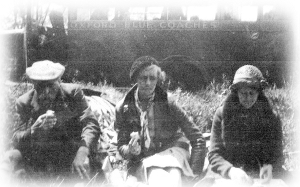
A school outing, 1930s: Mr Dring, the driver, Miss Stace
One of the events Miss Stace organised was an annual school trip, often to the seaside. She started a project on surveying, where the children made measurements and recorded various buildings in the village and also involved the children in bookcraft, making note books, folders and albums which were used in class and at home. She introduced a note of glamour to the village, riding her motorbike up the hill from Headington. Later she acquired a bull-nose Morris with a dickey seat and would take children out to the house she shared with her brother, himself a teacher, for tea. Best of all, she had a dog which could balance biscuits on its nose and toss them in the air before eating them.
Whatever Miss Stace’s shortcomings, many of the children who passed through her hands remembered her with affection. The school became a Primary school in 1948 and finally closed in 1955, with the Primary age children going to the neighbouring village of Beckley. The school which the Reverend Gordon founded in Marston, however, continues to this day providing education for 380 children. While he may have been sad to see the closure of Elsfield school, he can rest under his impressive headstone in the churchyard knowing that his ideas about education as a means of improving the lives of the village children were at the forefront of Victorian thinking and have now became an important part of the duties of the state.
